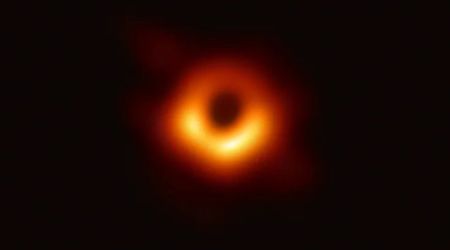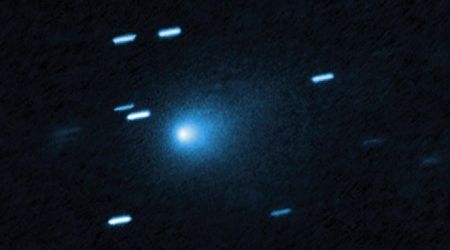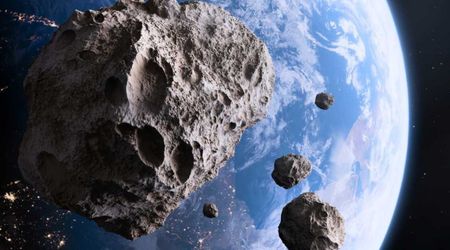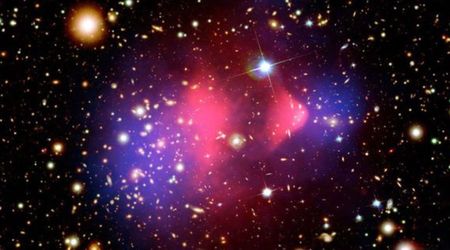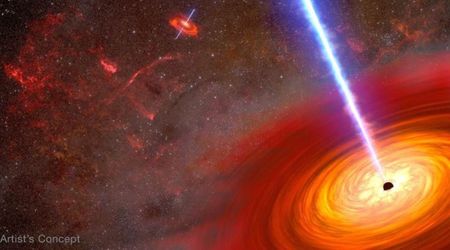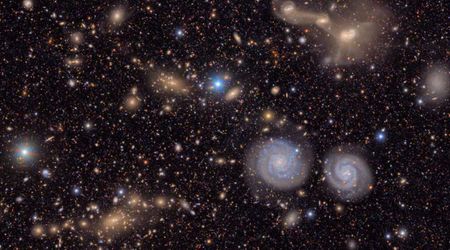Current theories on what could be bigger than the universe

Earth is inside the solar system which is inside the Milky Way Galaxy which is one of billions of galaxies and galactic clusters in the universe. But is there anything beyond that? Let’s explore the various theories and current science relating to what is “beyond” or “bigger” than the universe.
It’s often intriguing to consider the largest objects in the universe and our tiny place within them. In fact, many of the most interesting questions within astronomy essentially boil down to one simple question: “what is out there?”
For hundreds of years, we’ve used telescopes to expand our naked eye’s vision of the cosmos with increasingly impressive technology, definition, and scope. In fact, the discovery of and global acceptance of galaxies within the universe is a very modern idea that was hotly debated in the 1920s. That’s right. The idea that there are other galaxies, each containing billions of stars is only a century old.
So, what have we seen of the universe?
The observable universe or the limit of what we can see is about 93 billion light-years across, an area also known as the Hubble Volume.
But is this everything out there? To answer this question, we have to understand what we see.
Our universe is about 13.8 billion years old and has been expanding since that point meaning anything further away than 13.8 billion lightyears hasn’t had time to reach us yet due to the constraints of the speed of light (300,000 km/s). These objects are pitch black because the light hasn’t reached us yet, but that doesn’t mean they don’t exist. In addition, since the universe is expanding at an increasing rate, its size is ever-changing and the border is moving further away from us all the time (which is why the observable universe is bigger than the age of the universe, one of the biggest mind-boggling aspects of astronomy).
Based on current observations and understandings of physics and mathematics, the universe is much larger than our observable limit. We just can’t see it because the light hasn’t had time to reach us and this will not change with better telescopes since it is a constraint of lightspeed.
However, current observations show that once you get up to a certain scale (about 100 million light-years) it is pretty uniform so one particular 100-million-light-year chunk is statistically basically the same as another.
So, if we are asking what’s beyond or bigger than the observable universe, the basic answer is space that is generally similar to what we see in the observable universe.
But beyond that? Things get tricky, complicated, and quite honestly, likely impossible to ever prove.
However, there are a number of ideas that have been proposed by various astrophysicists and cosmologists, especially in recent years based on our current observations, understanding of physics and mathematics, and simulations based on the former two.
These can mainly be grouped based on two points:
- What we mean by the word “universe”
- Whether the universe is infinite or finite
The first point is fairly simple. Essentially, does the word “universe” mean “everything, everything at all” or something else?
For the second, astronomers look at the universe’s curvature to determine and measure its shape. If it is perfectly geometrically flat, it CAN be infinite. If it’s curved (like the Earth), it has finite value. The curvature of the universe is almost perfectly flat based on current observations and measurements. However, a flat universe does not have to be infinite because it could be like a cylinder which is geometrically flat but has a finite size, making it flat yet closed in on itself and therefore finite.
Essentially, we aren’t exactly sure if the universe is actually infinite or just incredibly inconceivably large but also finite. The latter has yet to be disproved and therefore is perfectly plausible.
But let’s move on to the current top theories of what is “bigger than” or beyond the universe based on these groups.
Finite Universe Theories
These are some of the top theories of what’s “beyond” the universe if the universe is finite and utilize a different definition of the word “universe” than “everything”.
Multiverse/ Infinite Bubbles Theory
If the universe is not infinite, this introduces a new definition of universe: Our universe is just a patch or bubble of space that is bound by our rules of physics. If this is how we define the “universe”, there are theories that there are other patches of space that are bound by other rules of physics, separated by massive voids that would be impossible for us to have enough time to travel between. Well-known scientists such as Stephen Hawking, Max Tegmark, Alan Guth, and Andrei Linda have been well-known for proposing and debating the intricacies of this theory.
In fact, some scientists have used this to propose the idea that if these universes come in contact with each other gravitationally, a Big Bang event could occur.

A Higher-Dimensional Construct/ “Dark Flow” Structures
This is another expansion of the basic idea of whether the universe is finite because one of the biggest questions that has been proposed since current observations of universe expansion is… expanding into what? Some of the main theories of this space beyond include:
- A Higher Dimensional Construct: There are objects that exist in one dimension (a line). two dimensions (a plane), and three dimensions (a cube and us!). In some exotic cosmology/ exotic gravity models, it is theorized our three-dimensional universe is embedded within a higher-dimensional construct, a four-plus-dimensional of something we can’t imagine since we experience the world in 3 dimensions.
- “Dark Flow” Structures”: There have been observations such as those of Kashlinsky et al. (2008) in which some parts of the universe are being pulled stronger than others. Kashlinsky et al. (2008) suggested the existence of unobservable outside forces or “dark flow” (2008) that we still don’t understand from massive structures outside our universe (and therefore could be part of the higher dimensional construct mentioned above). However, other research proposes it might be caused by another universe (i.e. Dr. Richard Holman) which brings us back to the second theory.
- Some combination of the two: Dark Flow Structures could be part of a higher-dimensional construct we don’t understand.

We Are Inside A Black Hole
Now I know this sounds crazy, but stay with me for a moment.
Remember, we can’t see a black hole because it distorts spacetime and nothing can escape its gravitational pull past the event horizon, including light which we need to see. So, if you were inside a black hole, you wouldn’t be able to see what lies beyond the event horizon.
Theoretical physicist Nikodem Pop?awski is probably the most well-known for this theory, in which he hypothesizes what we see as the universe is a fraction of a much bigger universe that got sucked into a black hole and has since expanded. This original offshoot event would have created what we see as the Big Bang.
This also means other black holes might contain other universes and outside of what we perceive as our universe is the much bigger, real/ proto universe, in which our “universe” simply resides as a tiny part of a black hole. And that proto-universe could have other universes within other black holes. The possibilities are endless.
Infinite Universe Theory
Multiples of More of the Same
As we stated before, we know that the universe is bigger than the observable universe, and is likely similar to what we see in the observable universe. However, if the universe is infinite, things eventually start to get… weird.
Infinity means that repetitions will eventually happen because there is only a finite number of ways that any set of particles can be arranged. These would create multiple Earths or even multiple versions of you that are slightly or very different than what we see here. Science fiction often likes to utilize this idea a lot with alternate realities, Earths, etc.
Therefore, if the universe is infinite, it could be simply more of what we know, to extremes with multiples of various degrees of everything.
This technically isn’t outside the universe, but it explains what’s “beyond”.
Finally: If “Universe” Means Everything
Whether the universe is infinite or finite, if the universe is EVERYTHING, then nothing is beyond or bigger than the universe.
That’s right, the answer to what is outside the universe is NOTHING.
Even if our universe IS finite instead of infinite, there actually doesn’t have to be an outside, as much as that boggles the mind to think about.
We typically think of the universe as a ball or balloon filled with galaxies, planets, etc. So if we are looking at the universe, we are looking at that balloon or we think of it being like an astronaut looking down on Earth but if that were to happen and our definition is everything then an outside observer would have to still be part of the universe. That outside perspective cannot exist or our universe is embedded in a higher dimensional construct which means a different definition of “universe”.
So even a finite universe does not have a boundary or an outside or doesn’t have to have an outside.
Even our typical understanding of “nothing” is a thing, an entity, a void, a vacuum, which makes it a part of the universe by that definition of universe. We can’t imagine it, but mathematics does not require an outside even of a vacuum. We can’t imagine it because it’s like asking what a color smells like.
If the universe is all there is and that’s it, there’s nothing outside of it.

Conclusion
Our understanding of the universe has massively evolved over the course of our own evolution. The beauty of science is actually how little we know. Some of the greatest minds in the world are currently pondering the question of what is the universe and what, if anything, is beyond.
The reality, as it is with many conundrums (like Pluto), is that it all depends on our definition. Is the universe everything that exists? Or is it something more finite and simply another part of all that is, with others like it somewhere out there? If it is the latter, the possibilities abound from multiple universes to universes (including our own) inside of black holes. And if it is the former, the answer is truly nothing.
One of the most intrinsic, human parts about us is our ability to wonder, to dream, and to imagine. Thanks to this, we have several theories about what lies “beyond” or is “bigger than” our universe that line up with at least certain current observations, physics, and math. The possibilities are truly beautiful.

